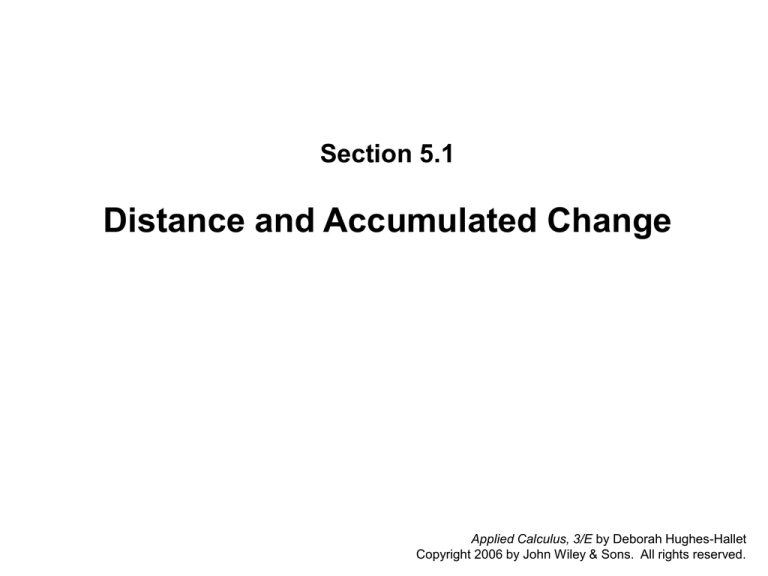
Section 5.1
Distance and Accumulated Change
Section 5.1: Distance and Accumulated Change
Applied Calculus, 3/E by Deborah Hughes-Hallet
Copyright 2006 by John Wiley & Sons. All rights reserved.
Suppose a car is moving with increasing velocity and
suppose we measure the car's velocity every two
seconds, obtaining the data in Table 5.1:
How far has the car traveled at most?
How far has the car traveled at least?
Applied Calculus, 3/E by Deborah Hughes-Hallet
Copyright 2006 by John Wiley & Sons. All rights reserved.
(ft/sec)
60
76
40
60
88
76
96
100
420 ft
88
96
360 ft
(sec)
Can we improve our estimate?
fig 5.2 page 238
Applied Calculus, 3/E by Deborah Hughes-Hallet
Copyright 2006 by John Wiley & Sons. All rights reserved.
Yes, if we know the
velocity at more
points in time.
Figures 5.3
Applied Calculus, 3/E by Deborah Hughes-Hallet
Copyright 2006 by John Wiley & Sons. All rights reserved.
Figures 5.4
Applied Calculus, 3/E by Deborah Hughes-Hallet
Copyright 2006 by John Wiley & Sons. All rights reserved.
Figures 5.5
Applied Calculus, 3/E by Deborah Hughes-Hallet
Copyright 2006 by John Wiley & Sons. All rights reserved.
Figures 5.6
Applied Calculus, 3/E by Deborah Hughes-Hallet
Copyright 2006 by John Wiley & Sons. All rights reserved.
A sports car accelerates from 0
ft/sec to 88 ft/sec in 5 sec. Find
lower and upper bounds for the
distance traveled in 5 seconds.
230 ft
318 ft
In which time interval is the average acceleration greatest? Smallest?
0-1 sec has an average acceleration of 30 ft/sec2
4-5 sec has an average acceleration of 2 ft/sec2
Applied Calculus, 3/E by Deborah Hughes-Hallet
Copyright 2006 by John Wiley & Sons. All rights reserved.
70 m
Velocity (m/sec)
Find lower and upper bounds for
the distance traveled in 5 seconds
by an object whose velocity is
given by the graph below.
130 m
Time (sec)
Applied Calculus, 3/E by Deborah Hughes-Hallet
Copyright 2006 by John Wiley & Sons. All rights reserved.
85 m
Velocity (m/sec)
Find lower and upper bounds for
the distance traveled in 5 seconds
by an object whose velocity is
given by the graph below.
115 m
Time (sec)
AtFigures
what time(s)
is the acceleration zero?
5.6
2 and 4 sec
Applied Calculus, 3/E by Deborah Hughes-Hallet
Copyright 2006 by John Wiley & Sons. All rights reserved.
Two cars start at the same time and travel in the same direction along a straight
road. The figure below gives the velocity, v, of each car as a function of time, t.
Which car reached the larger maximum velocity?
A
Which car traveled for the longer time?
B
Which car traveled the greater distance?
A


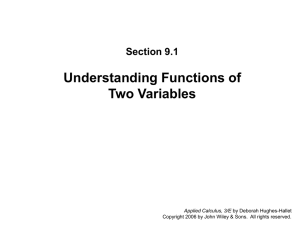
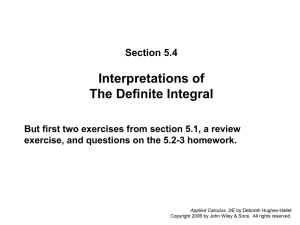
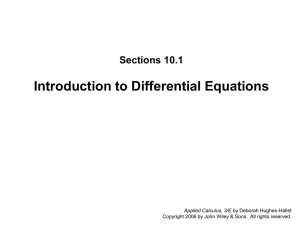
![Global max/min [4.3]](http://s2.studylib.net/store/data/005700750_1-6d8aea91972157c1c45aa1008072a9fe-300x300.png)
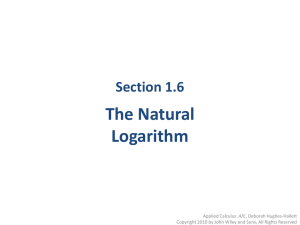
![Local max/min [4.1]](http://s2.studylib.net/store/data/005703785_1-fddedba53a949b6dd73bfcae3f9e6954-300x300.png)




